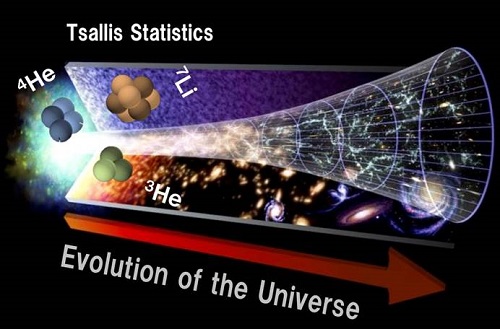Big Bang is regarded as the most successful model to describe the origination and evolution of universe currently. The model describes how the universe expanded from a very high density and high temperature state, and offers a comprehensive explanation for a broad range of phenomena, including the abundance of light elements, the cosmic microwave background (CMB), large scale structure, Hubble's law, and the abundances of p, D,3He and 4He. However, the 7Li abundance is over-predicted by a factor of three. This inconsistency is called Lithium problem.
Recently, an international nuclear astrophysical team led by Suqing Hou (Institute of Modern Physics, Chinese Academy of Sciences) and Jianjun He (Institute of Modern Physics & National Astronomical Observatories, Chinese Academy of Sciences), proposed an elegant solution to this problem by introducing non-extensive statistics. The authors show that using a slightly modified version of the classical distribution (non-extensive statistics), they can successfully predict the observed primordial abundances of deuterium, helium, and lithium simultaneously (seen in Fig.2).
This work was jointly supported by funding agencies such as National Natural Science Foundation of China, Major State Basic Research Development Program of China, Spanish Ministry of Science and Innovation, National Science Foundation (US), Department of Energy (US). Other institutions involved in the research include the Universitat Politècnica de Catalunya (Spain), Institut d'Estudis Espacials de Catalunya (Spain), The University of Tokyo (Japan), National Astronomical Observatory of Japan (Japan), Beihang University (China), University of Notre Dame (US), Texas A&M University- Commerce (US).
This work has been published in Astrophysical journal, a world famous scientific journal of astrophysics and astronomy. The paper was also highlighted on the official site of AAS NOVA (Research highlights from the journals of the American Astronomical Society:http://aasnova.org/). The post is here: http://aasnova.org/2017/02/15/fixing-the-big-bang-theorys-lithium-problem/
The article can be linked as follows:http://iopscience.iop.org/article/10.3847/1538-4357/834/2/165.

Fig.1: Artist’s representation of the evolution of the universe, with time flowing to the right in the direction of the red arrow. Original picture is taken from NASA and modified by IMP.

Fig2. Predicted primordial abundances as a function of non-extensive statistics parameter q (in red solid lines). The observed primordial abundances with 1σuncertainty for D, 4He, and 7Li are indicated as hatched horizontal bands. The vertical (blue) band constrains the range of the parameter q to 1.069≤q≤1.082.

